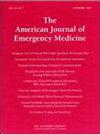Suprascapular nerve block for analgesia in traumatic scapular fractures performed by emergency physicians: A case series
IF 2.2
3区 医学
Q1 EMERGENCY MEDICINE
引用次数: 0
Abstract
Scapular fractures, typically resulting from high-energy trauma, cause severe pain that restricts shoulder girdle movement and delays rehabilitation. Adequate analgesia is essential to facilitate physiotherapy and improve recovery, yet optimal techniques remain underutilized in the Emergency Department (ED). Suprascapular nerve block may offer an effective solution to this challenge.
We report a series of ten adult patients with traumatic scapular fractures who presented to the ED with severe pain (Defense and Veterans Pain Rating Scale ≥7) and a mean Injury Severity Score (ISS) of 30. All patients underwent ultrasound-guided suprascapular nerve block performed by trained ED physicians using point-of-care ultrasound. Pain scores were recorded at baseline, 30 min, 60 min, and 2 h after the block, and adverse events were monitored for two hours.
The mean baseline pain score was 8.9 ± 0.7, which reduced to 2.9 ± 0.9 at 30 min, 1.5 ± 0.97 at 60 min, and 1.1 ± 0.3 at two hours post-procedure (p < 0.001). All ten patients achieved at least a 50 % reduction in pain within 30 min. Complications such as pneumothorax, vascular puncture, or local anesthetic toxicity were not observed. All patients were able to move their shoulders without pain within an hour of the block.
Ultrasound-guided suprascapular nerve block is a rapid, safe, and highly effective analgesic intervention for traumatic scapular fractures in the ED. In the future, a randomized controlled trial should be performed to prove the efficacy of the suprascapular nerve block in providing analgesia for traumatic scapular fractures.
急诊医生对创伤性肩胛骨骨折进行肩胛上神经阻滞镇痛:一个病例系列
肩胛骨骨折通常是由高能创伤引起的,它会导致严重的疼痛,限制肩胛骨的活动,并延迟康复。适当的镇痛对于促进物理治疗和改善康复是必不可少的,然而在急诊科(ED)仍未充分利用最佳技术。肩胛上神经阻滞可能是解决这一问题的有效方法。我们报道了10例外伤性肩胛骨骨折的成人患者,他们在急诊科表现为严重疼痛(国防和退伍军人疼痛评定量表≥7),平均损伤严重程度评分(ISS)为30。所有患者均接受超声引导的肩胛上神经阻滞,由训练有素的急诊科医生使用即时超声进行。在阻滞后的基线、30分钟、60分钟和2小时记录疼痛评分,并监测不良事件2小时。平均基线疼痛评分为8.9±0.7,术后30分钟降至2.9±0.9,60分钟降至1.5±0.97,术后2小时降至1.1±0.3 (p < 0.001)。所有10例患者在30分钟内疼痛至少减轻了50%。并发症如气胸,血管穿刺,或局部麻醉毒性未观察到。所有患者在手术后一小时内都能无痛地活动肩膀。超声引导下肩胛上神经阻滞是一种快速、安全、高效的外伤性肩胛骨骨折的镇痛干预手段。未来需要进行随机对照试验来证明肩胛上神经阻滞对外伤性肩胛骨骨折的镇痛效果。
本文章由计算机程序翻译,如有差异,请以英文原文为准。
求助全文
约1分钟内获得全文
求助全文
来源期刊
CiteScore
6.00
自引率
5.60%
发文量
730
审稿时长
42 days
期刊介绍:
A distinctive blend of practicality and scholarliness makes the American Journal of Emergency Medicine a key source for information on emergency medical care. Covering all activities concerned with emergency medicine, it is the journal to turn to for information to help increase the ability to understand, recognize and treat emergency conditions. Issues contain clinical articles, case reports, review articles, editorials, international notes, book reviews and more.

 求助内容:
求助内容: 应助结果提醒方式:
应助结果提醒方式:


